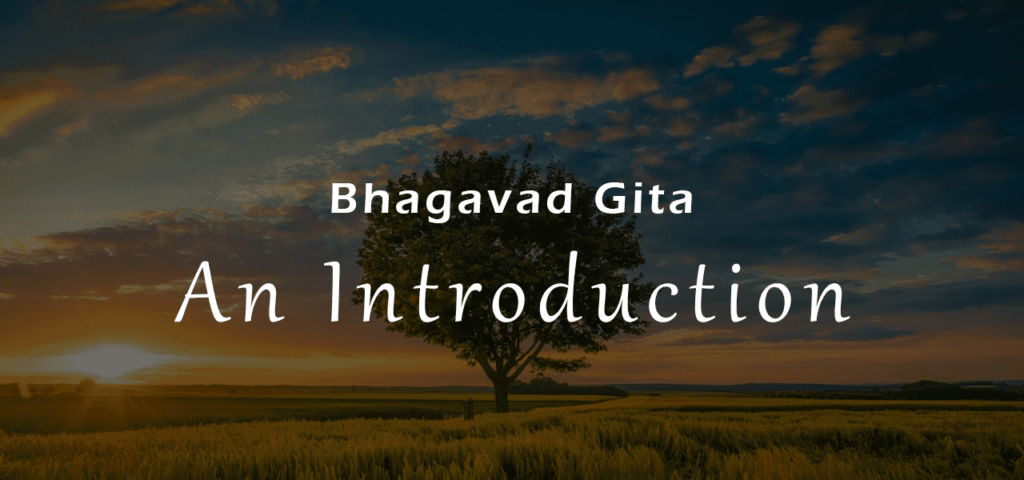Bhagavad Gita, one of the most revered scriptures of Hindus is also an important philosophical treatise. It relates not to any particular sect of Hindus, but to Hinduism as a whole. In fact it represents dharma, religion as such.
Literally meaning ‘Song of the Divine’, Bhagavad Gita is a composition of seven hundred and one couplets, comprised in eighteen chapters. It is written in Sanskrit language. Part of the great epic of Mahabharata, it is stated to have been compiled by Rishi Ved Vyasa.
Traditionally, it is believed that Gita is more than five thousand years old. But most of the scholars and researchers are of the view that this poem of divinity originated around 200 B.C.
When there is a decline in the values of righteousness and the forces of evil start rising, God incarnates Himself to set the things right. He comes to earth in the form of a human being. Krishna is depicted as such an Avatara. He is stated to be the incarnation of Vishnu. In Gita, Krishna speaks as the Supreme Lord.
A war between two closely related and intricately interwoven families forms the canvas on which these immortal words of infinite wisdom have permanently been imprinted. This war, popularly known as the war of Mahabharata, was fought between Pandavas and Kauravas, at Kurukshetra.
When, at the outset of the war, the two armies were facing each other, Pandava prince Arjuna, the great archer of the world, requested Lord Krishna, who was his charioteer at that point of time, to take his chariot between the two formations.
On seeing many near and dear ones standing in the opposite army, Arjuna wondered whether instead of killing and maiming his respected elders and loved youngsters, would it not have been better for him to allow himself to be killed. Looking at the impending bloodshed, he felt distressed and told Krishna that he did not want to fight this war. He then sought Krishna’s advice.
When exhorted by Krishna not to run away from fighting a righteous war, which was his duty as a warrior, Arjuna enquired if it was possible for him to renounce the status of warrior and live life like a sannyasi. Krishna’s answers to these questions and the responses to the doubts raised by Arjuna form the content of Bhagavad Gita. Depending upon the context, this guide of appropriate human behaviour is presented in both the forms, as a conversation between two individuals and also as a discourse of the Supreme Lord.
This dialogue between Arjuna and Krishna was narrated to the blind Kaurava king Dhratarashtra, by Sanjay. Sanjay could see and hear the war from a long distance, by the divine vision granted to him by Vyasa.
Though set against the backdrop of a war, Gita is not the description of a battle between two kings. It rather prescribes a universal code of conduct which, if followed sincerely, can simultaneously ensure both materialistic growth and spiritual realisation. It does not propagate any discrimination on the basis of gender, cast or creed. In this regard, it needs to be appreciated that the first shloka of Bhagavad Gita starts with the word ‘dharamkshetre’ which means in the field of righteousness. It implies that the teachings of Gita are within the parameters of dharma i.e. righteous way of living.
Gita represents the very essence of Vedas. It also brings about a synthesis of different schools of Hindu thought. All elements of Hindu life have, in fact, been drawn into an organic unity.
It covers a broad range of spiritual, philosophical, ethical and socio-religious aspects of human life. It addresses the most fundamental of questions – what is the meaning of life, what is the purpose of life ; and how can one lead a blissful life.
It discusses ways and means by which one can overcome his limitations and achieve his full potential. More than a theoretical concept, Bhagavad Gita is a practical guide in day to day life.
The dilemma which Arjuna faced in the battlefield of Kurukshetra i.e. whether to follow the path of righteousness and deal with the consequences boldly or to compromise with the evil, is being faced by all of us, on daily basis. In fact, the dilemmas faced and the resultant distresses experienced are much more severe now due to the multiplicity of avenues and the consequent choices available to us today than in the past.
In the contemporary world of cut-throat competition, the message of oneness of mankind given by Krishna becomes all the more relevant. Leading an aware, active, devoted, equanimous, joyous, caring and balanced life is the mantra given by Lord Krishna. Teachings of Gita, if properly understood, truly internalised and sincerely followed can certainly help everyone of us in taking right decisions at appropriate time. One can lead a life of serenity even while fighting vigorously for his place in the world. One can thus enjoy the beauty and grandeur of life.


Awesome content, Thanks
Прогон сайта с помощью Хрумера может помочь улучшить позиции сайта в поисковых системах, повысить его трафик и увеличить количество потенциальных клиентов. Однако, не следует забывать, что использование Хрумера может повлечь за собой риск нарушения правил поисковых систем, таких как Google, что может привести к наказанию и снижению рейтинга сайта.